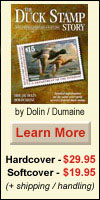 |
10% off on
web orders over $100 |
|
|

|
|
RW1 Plate Block Sells for $27,500
A nearly perfectly centered, mint, never- hinged plate block of six of the first federal-issue United States migratory bird hunting stamp (Minkus RH1 / Scott RW1) sold for $27,500, which includes the 10% buyer’s premium, in Robert A. Siegel’s Sept. 20 auction in New York City.
Catalog values for this elusive multiple range from $10,000 to $12,500 — obviously a bit on the lean side for this particular offering, shown below in Figure 1.
The record price is understandable, because of the centering of the plate, color, and what Siegel describes as "A true condition rarity" - that is, a philatelic object that is rare by virtue of its overall quality.
The description mentions "usual few tiny natural gum skips and faint natural gum bends as always found on this issue." I would take exception to their use of their phrase “always found on this issue,” as I have seen at least a half dozen of these plate blocks free of such anomalies.
The plate block does have full side selvage - a definite plus - and the centering is spectacular.
Usually some perf separations are present on this issue, and since none are mentioned in the description, it could qualify as a condition rarity. In fact, a plate block of the 1934 issue is a rarity in anybody’s book, in nearly any condition.
Why is this plate block so difficult for collectors to find?
To answer that question, we must refer to the Postal Regulations issued in 1934, which among other things, allowed only one stamp be sold per patron. The stamp had to be affixed to a state license or Form 3333 in the presence of the postmaster.
It was not until June 15, 1935, long after hunting season ended, that post offices were permitted to sell multiples of this stamp. Since the stamp was taken off sale on June 30, a window of only two weeks existed for the public to buy multiples.
A fair presumption would be that some postal window clerks were not aware of these regulations, and sold multiples prior to the authorized date. However, most probably did follow the new rule.
Another factor in the rarity of multiples of this issue was surely the cost of $1 per stamp — a lot of money in 1934.
Not many would pay $6 for a plate block. Those who would had to find a clerk who still had six stamps in plate block form, and was willing to sell them, perhaps in spite of postal regulations.
Now, let’s talk about the survivors. Of the very few sold 68 years ago, how many do you think made it to 2002 intact?
Of those, how many were well-centered, never-hinged? How many of them were free of faults? In my experience, about 15.
We must add to the mix one more substantial factor: the existence of the Jeanette Cantrell Rudy collection, which contains about 12 perfect or near-perfect 1934 duck stamp plate blocks.
Mrs. Rudy obtained these plates for her collection over the last 20 years in her effort to complete all plate numbers of all duck stamp plate blocks. She has not completed the feat, lacking only this first issue, and one or two other oddball plate blocks. Her collection will be donated to the National Postal Museum upon her death.
All these factors have caused collectors to get into a bidding frenzy when a top-quality plate block comes on the market. The result was a realization of $27,500 for that plate block on that day.
The same sale also offered most other duck stamp plate blocks, including a perfect 1935 plate block (Minkus RH2 / Scott RW2), illustrated above in Figure 2.
This second issue plate also brought a very high price of $15,950, including commission, over a catalog value in the $9,000 to $10,000 range.
The 1935 issue is the scarcest federal duck stamp, with only 448,204 sold, versus 635,001 duck stamps of 1934. Plate blocks are not as scarce for the reasons mentioned earlier surrounding the first issue, but an impeccable 1935 plate block is hard to find nonetheless
Although I have not seen the item personally, this example would certainly seem to qualify as such a gem and earn the premium price it brought. |
|
|



















